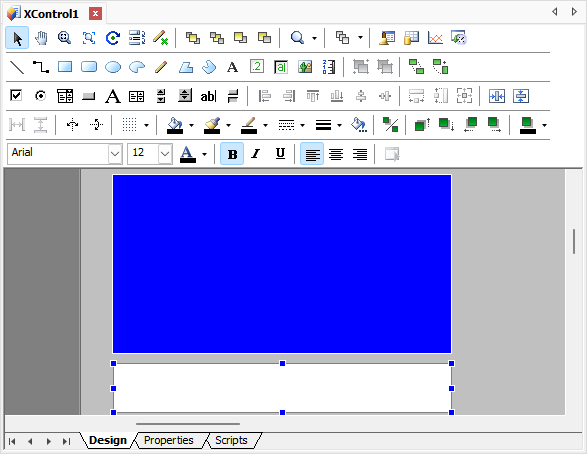An XControl defines a graphical interface for users, which can be composed of any Elipse E3 objects, aiming to be easily replicated by a project. Users can create an XControl by right-clicking a .lib file created in a Domain or the Objects Library - XControls item, and then selecting the Insert - XControl option.

Design tab of an XControl

Properties tab of an XControl
When inserting an XControl, please notice that on the lower part of its screen there are Design, Properties, and Scripts tab. On the Properties tab, users can insert properties that are exported by this object. These properties can be linked to a Tag or to any other property when this object is used in a project. On the Design tab, which is equivalent to a Screen, users can insert all graphical objects previously described.
All properties exported by an object, the XProperties, can be inserted by using the INS key or by clicking Add ![]() , and deleted by clicking Delete
, and deleted by clicking Delete ![]() . The available options are described on the next table.
. The available options are described on the next table.
Available options on Properties tab of an XControl
Option |
Description |
|---|---|
Name |
Determines the name of this XControl's Property |
Type |
Determines the data type supported by this Property |
Public |
Enables or disables Property's visibility outside this library, that is, determines whether this Property is public or not |
Persistable |
Determines whether this Property is saved in a project or not |
Retentive |
Determines whether this Property is retentive or not. For XControls, Properties cannot be retentive |
Initial value |
Determines the initial value of this Property |
Help text |
Declaration and documentation text of this Property |
Notice that other Data objects, XFolders and XObjects, can be declared as data types. This allows a single Property to control an object, making it easy to maintain a library.
Editing this object has the same graphical resources and options as editing a Screen. Users can insert XControls on any Screen, or even inside another XControl by right-clicking a destination Screen or XControl and selecting the Insert option.
Then, this XControl has a name inside a Screen, and it is known as a copy of its original definition. Thus, users can, if needed, define values or Links this specific copy has in its usage context.